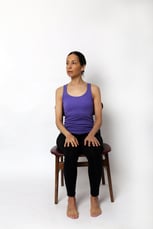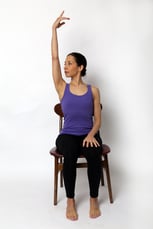Core imbalance wreaks havoc on people of all shapes, sizes, and occupations. The following is a synopsis of two of my patients, who had very different lifestyles:
 Tracy, a middle-aged office worker, spent 40 hours a week at her desk, hunched over a computer, and talking on the phone. Additionally, her commute to and from the office on a bus was 25 minutes each morning and evening. She exercised regularly but was suffering from lower back pain.
Tracy, a middle-aged office worker, spent 40 hours a week at her desk, hunched over a computer, and talking on the phone. Additionally, her commute to and from the office on a bus was 25 minutes each morning and evening. She exercised regularly but was suffering from lower back pain.- Kyle, a personal trainer, was in his earlier thirties and spent all day at a gym teaching spin and other fitness classes. He came to me for help with back and shoulder pain, as well as debilitating migraine headaches.
The commonality between these two patients? Despite having very different symptoms and lifestyles, they both had core imbalance. They both spent too much time working on their abs! Tracy was constantly hunched over her computer and sitting on the bus, so her abs were contracted for most of the day. Kyle, the personal trainer, was doing a lot of crunches and sit-ups, and also curling over his bike in spin class.
What is Core Imbalance
Whether a person’s abs are pulled tight because of bad posture, long periods of sitting, or physical exercise, the results are the same - core imbalance. Core imbalance is the condition of excessive compression, which results in the spine curving forward. The resulting back and neck pain can be caused by sitting at a computer or driving a car, and it can also be self-imposed on your quest for six-pack abs by doing crunches or other improper core training.

Myth 1 of my Six Myths on Getting A Six Pack in 3 Weeks To A Better Back is "Strong Abs Means A Strong Back" - Rather, the key to a strong back is balanced abdominal muscles, which means working your core equally with other muscles in your body. More detailed info on core imbalance can be found in my new book Sit-Ups Are Stupid & Crunches Are Crap.
How To Assess Your Core
The Deep Breath Test gives you a better understanding of compression and expansion and can help you relax. Do the following:
- Slouch in your chair, and let your arms hang down. Your hands will naturally rotate inward. Try to take a deep breath.
- Now sit up tall, extend both of your arms at your sides (like airplane wings), and take a deep breath.
- Try it one more time with your arms straight up.
As you can see, you can take a much deeper breath by merely improving your posture, which opens up your chest. To assess your individual core imbalance, you can take the following test:
- Sit in a chair facing forward and with your feet on the floor. Then, turn your head to the right and note how far you can see behind you.

- Turn back to your starting position and lift your right arm above your head. Now turn your head to the right again.

If you can see farther with your arm raised, then you have a core that is out of balance. By elevating your arm, you are stretching your abdominal muscles, allowing a muscle release to happen. If you need a release to gain vision, your abs are the culprit of your decreased range of motion.
Treatment for Core Imbalance
When treating my patients with core imbalance and subsequent back pain, I’ve learned the following two rules about combating back pain that stems from misuse of the abdominals:
- For every forward movement, there needs to be a counter-movement. It’s vital that we put extension into our routine to counteract flexion, or crunching or hunching. With regular use of my anti-core imbalance exercises and using a Backbridge, you should feel the expansion of the chest and relief in the back.
- Every time you contract a muscle, you need to be sure to relax it. It doesn’t matter if you are a body-builder (who frequently are incapable of turning their heads because the muscles are so tight), or a trader or surgeon who faces constant stress, you need to find a way to release those muscles.
A full three-week treatment for core imbalance can be found in 3 Weeks To A Better Back, but the following are a few tips that can get you on a path to a balanced core and less back pain:
- The Backbridge - After seeing many patients with core imbalance, I started to study the benefit of extension therapy. But, it wasn’t until I began working with a patient, an ESPN fitness model, that I had my “aha” moment. She was the picture of health, aside from suffering from neck and back pain as a result of the thousands of sit-ups and crunches she was doing. I grabbed an exercise ball and had her lay on her back and stretch over it. After a few minutes, she felt better. I then took the ball to show my father, and he proceeded to lie over the ball - and fell off! I knew I was on to something but needed to make it safe for all users. So, I invented the Backbridge as a safe tool for all back pain sufferers. With its five different levels, it allows anyone to use it comfortably by progressively undoing your forward hunch and forward compression. Two minutes, twice a day on the Backbridge doing extension exercises, is enough to let the spine curve back slightly and detailed exercises can be found here.
- Anti-Core Imbalance Exercises – Over-exercising, under-exercising, or doing the wrong exercises that put more forward flexion into your abs can cause imbalance, which will eventually lead to back pain. In a future post, I will detail several anti-core imbalance exercises that can be done to start to balance your core.

